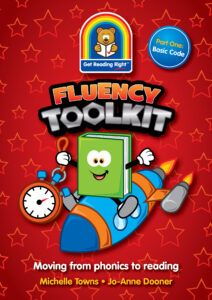By Kelly Malone
15 Oct 2021
I wanted to share one of the biggest success stories I witnessed in my role as an Instructional Leader. I had been working closely with a FABULOUS year 2 teacher, who was returning to class after a number of years in a learning and support role. Things had changed at the school since she was last on class. The school was investing much time and resources into the professional learning around the science of reading.
To cut a long story short, this teacher wanted to work on building fluency with her class. We had been learning about the important role it plays in moving kids from phonics, and how it supports comprehension.
Enter the Get Reading Right Fluency Toolkit!
Together we decided to dedicate just 5 minutes a day to fluency. And away we went… Modelling reading of single words, phrases, and sentences. Choral reading. Cold calling. Little class competitions. Timed reading, paired reading. Echo reading. In a very short period of time, this teacher had established a wonderful routine of fluency practice with her students.
Over the next few months, I observed this group of students (full of reluctant readers) not only build their fluency. But their confidence. They read aloud together during morning routine with beautiful pace, and prosody. During guided reading, they read poetry and narratives utilising character voices. They paid closer attention to punctuation. They had buddy systems, where more confident readers supported struggling readers. They provided each other with feedback and praise. To see the change in these students’ reading confidence, and their teacher’s confidence, is something I’m incredibly proud of and will always remember. All it took was knowing the research and being willing to put it into practice!
When it comes to teaching reading, let’s not ignore the crucial role fluency plays. Here is my Fast Fluency Five – 5 things teachers need to know about fluency.
1. Fluency is…
Fluency is the ability to read words effortlessly, with automaticity. Fluency is reading accurately, quickly, and with appropriate phrasing and intonation. Tim Rasinski states that fluency is accuracy in word recognition (decoding), automaticity in word recognition, and interpretation and meaningful reading. Research has also shown a two-way relationship between reading fluency and comprehension: when children read more fluently, they understand what they read better, and when children understand what they are reading they read more fluently. However, fluency has stronger effect on comprehension than vice versa (Klauda & Guthrie, 2008; Pikulski & Chard, 2005).
2. Fluency is not…
Fluency is not simply reading quickly. A very common misconception is that reading fluency is the ability to read aloud at pace, achieving a certain number of words correct per minute. What we know, is that fluency is much more than that. Fluency requires not only appropriate pace, but accuracy and prosody. If we emphasise speed at the expense of prosodic and meaningful reading, we will end up with fast readers who understood little of what they have read. (Rasinski 2004)
Read really fast. Read like a river, not like a robot, or like a speedboat!
3. Fluency is important…
Fluency is important to reading instruction and reading development. This is because when we read, we essentially have to do two things. First of all, we have to read the words. Decode. We need to develop this to automaticity. With accuracy. With appropriate prosody. This frees up space in working memory to focus on the second thing. Making connections between vocabulary and our schema to comprehend the text. When we cross the ‘fluency bridge’ from decoding and add prosody, we get meaning. Reading fluency is an important part of reading proficiency and reading a text fluently is critical to comprehending it. (Hudson et al 2012) Fluent readers do not have to concentrate on decoding the words, therefore they can focus their attention on what the text means.
4. Fluency instruction should be…
Fluency instruction should be direct and explicit. It requires intentional practise. Teachers should plan to teach fluency as part of an effective phonics and/or reading program. Modelled, guided and independent practice, and providing feedback at all stages, is essential. Dedicating small chunks of your day to fluency instruction is a simple, yet effective change to make! Systematic, direct and explicit instruction of reading fluency is considered imperative, since many students and mostly those with reading difficulties face problems in reading speed and prosody, despite their adequate decoding skills. (Padeliadu & Giazitzidou 2018)
5. Fluency in practice…
Fluency in practice doesn’t have to be daunting, or time consuming. Fluency in the classroom can be incredibly fun, engaging and rewarding! Why not try three of my favourite approaches?
- Repeated reading
Repeated reading is an evidence based approach to fluency instruction. You can implement repeated reading in small groups, or one-to-one. Select a text the child can read with minimal errors, model reading the text, listen to the student read, provide corrective feedback, have the student read the text up to four times.
For more information check this out: https://fivefromfive.com.au/repeated-reading/
- Choral reading
Choral reading works well whole class or in small groups. It is reading aloud, in unison. Choral reading chunks of a text during guided reading is by far more beneficial than round-robin reading. Model reading a text, students choral read. Choral reading can be applied throughout all KLAs.
Watch it here:
- Echo reading
Echo reading provide a strong scaffold for reading fluency. Read a section of a text modelling fluency. Then read it sentence at a time. The students then echo your reading after each sentence. Simple. Effective. Easily added to your guided reading sessions, or whole class reading.
Watch it here: https://www.youtube.com/watch?v=4gRXca5G-Ow
If you want to make a change to your reading instruction, make small changes to the way you teach fluency. Hopefully you see the same effects that I did. Sometimes the smallest changes can have the biggest impact.
Kelly Malone
Want to know more about Fluency instruction?
Check out Get Reading Right’s brand new Fluency Toolkit: http://www.getreadingright.com.au/shop/new-products/pre-order-fluency-toolkit-kindy/
The Essentials of Developing Reading Fluency https://www.youtube.com/watch?v=OM-mi_4usvE
Five from Five – Fluency https://fivefromfive.com.au/fluency-4/

